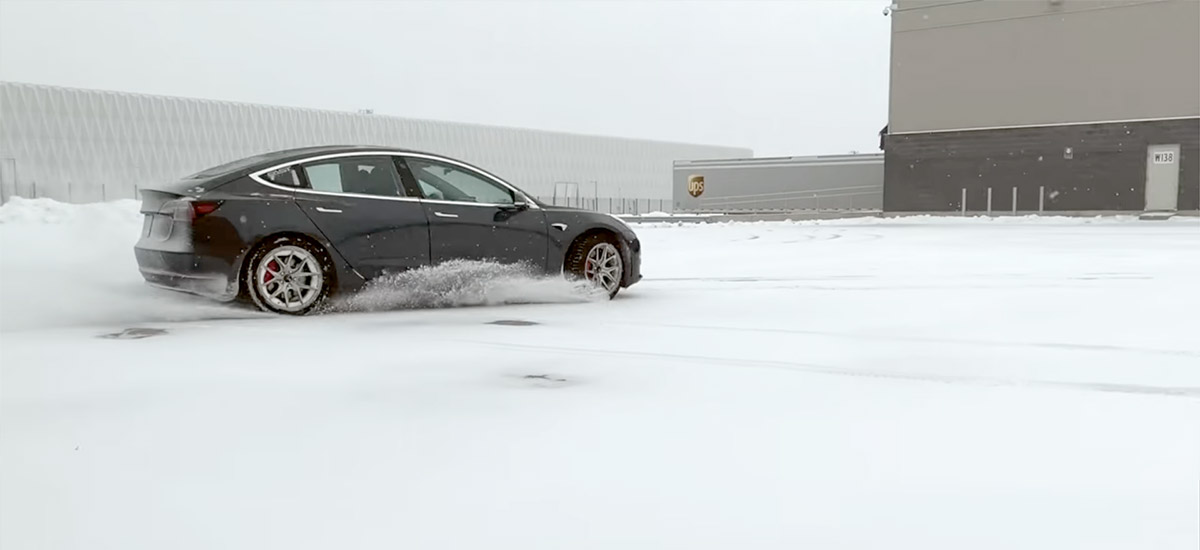
With Winter Tires + Track Mode, Tesla Model 3 Performance turns into a ‘Snow Leopard’
If you want to have fun in the holiday season there’s no better way to enjoy a Tesla Model 3 Performance with snow tires and ‘track mode‘ ON — what you’re about to witness is nothing else but sheer joy for a Tesla Performance vehicle owner, specially a Model 3.
Earlier this month Tesla unleashed an over-the-air software update called the ‘Track Mode’ for Model 3 Performance vehicles, this update includes enhanced stability control and powertrain settings that turn your car into a hungry track animal.
Tesla also released a short video demonstrating the abilities of a Model 3 Performance on a race track:
How about experimenting the same stuff on snow/ice? Yes, that attempt has been made and it looks and feels amazing.
Our co-author Ian Pavelko drove a Tesla Model 3 performance with winter tires and track mode on snow and it truly reminds me of a Snow Leopard’s agility and control while hunting its prey in the icy high mountains.
Smooth handling and control via the onboard Tesla software make snow drifting in track mode look like a breeze.
Ian equipped his Performance Model 3 with ‘Nexen WinGuard Sport V-Rated winter tires in 235/45R18’ on an 18″ wheel (same wheel used for Model 3 0-60 new record last month) and drifted the car on snow, you can see what happened next in the video he shot for viewing pleasure.
Related: Getting the best out of your Tesla/EV in the cold weather
How Track Mode Works:
Tesla released a detailed blog post about How ‘Track Mode’ works for performance vehicles, you can read the blog post in its entirety below:
Electric powertrains have numerous advantages over internal combustion engines. In addition to the low cost of ownership, energy efficiency, and near silence, they also offer unparalleled responsiveness. Since the introduction of Tesla Roadster in 2008, we’ve exploited the immediate availability of motor power and torque to achieve unprecedented straight-line performance, making the car’s forward acceleration a pure extension of the driver. With Track Mode, which is designed specifically for use on closed autocross circuits and racetracks, our goal was simple: use that same motor power and torque to make cornering on the track feel just as natural as forwarding acceleration.
The fundamentals
How does motor power help you corner? If you’ve ever pulled a car’s handbrake in an icy parking lot, you know that you can make a car turn with more than just the steering wheel. That’s because torque – whether accelerating or decelerating a vehicle – reduces a tire’s ability to hold the car in a turn. Apply torque to the rear wheels, and the car will rotate more in the turn (if you see a car drifting, that’s drive torque; or think about pulling that handbrake, that’s brake torque). Conversely, if you apply either kind of torque to the front wheels, this reduces a car’s ability to turn.
By precisely controlling whether torque goes to the front or the rear wheels, Model 3’s dual motors can immediately and silently increase or decrease the car’s rotation in a corner at your request. This requires a lightning fast torque control and the ability for the car to precisely regulate traction on each tire – both of which are standard features in every Tesla, but that we’ve expanded upon with Track Mode to make highly technical driving effortless.
More than just stability
The most exciting aspect of Track Mode is how we can change the balance of the car using just the motors – a technique that would typically be interrupted by a system known as stability control.
Stability control is an important safety feature found in all modern passenger vehicles that apply brakes to certain tires in order to prevent your car from spinning out of control during dynamic maneuvers. The feature is designed to make a car’s behavior more predictable in emergency situations, but it also constrains a driver to a limited range of capabilities at the expense of driver authority and fast lap times. As a result, many cars have “sport” modes that reduce or even disable these safety systems in order to allow a professional driver to maximize the capability of what a car can offer.
Instead of taking away features to enhance the experience of professionals, Track Mode adds features to make any track driver, amateur or professional, feel superhuman on a track. This is possible because, with Model 3 Performance, we replaced the stability control system with our own in-house Vehicle Dynamics Controller – software developed specifically for Tesla vehicles that acts both as a stability control system and also as a performance enhancement on the track.
More features, not fewer
Here is a summary of many of the features we employ with Track Mode while you’re on the track:
Motor Torque for Rotation
Our Vehicle Dynamics Controller constantly monitors the state of the vehicle and all of the inputs from the driver to determine the driver’s intention and affect the rotation of the car in a matter of milliseconds. Track Mode relies heavily on the front and rear motors to control the car’s rotation, and we have the ability to command a 100% torque bias. When cornering, if rotation is insufficient to the driver’s request, the system commands a rear biased torque. Conversely, when rotation is excessive, we command a front biased torque.Increased Regenerative Braking
Heavy regenerative braking may not be comfortable for day-to-day driving, but on a track, it has several key advantages. It gives the driver more authority with a single pedal, improves the endurance of the braking system, and sends more energy back into the battery, maximizing the battery’s ability to deliver large amounts of power. It also gives the Vehicle Dynamics Controller more authority to create or arrest rotation with the motors when your foot is lifted off of the accelerator pedal.Track Focused Powertrain Cooling
The high output power required for track driving generates a lot of heat, so endurance on the track requires more aggressive cooling of the powertrain. We proactively drop the temperatures of the battery and the drive units in preparation for the track and continue to cool them down in between drive sessions. We can also allow operation of the powertrain beyond typical thermal limits and increase our refrigerant system capacity by overclocking the AC compressor into higher speed ranges.Enhanced Cornering Power
We typically think of using brakes to slow down a car, but you can actually use them to make the car faster out of a corner. All Model 3s are equipped with open differentials, which send an equal amount of torque from the motors to both the left and right wheels. When cornering, the wheels on the inside of the corner have less load on them, which means they can provide less tractive force than the outside wheels. To prevent excess slip on this inside tire, we have to limit the torque for both wheels, leaving power on the table. In Track Mode, we simultaneously apply brake and motor torque to produce a net increase in tractive force while cornering. This is similar to how a limited slip differential works, except when using the brakes, the differential can be optimized for various driving conditions.Model 3 Performance with Track Mode integrates active controls with the vehicle’s already planted chassis and nimble, responsive steering by maximizing the driver’s authority under any condition. We do this with the same secret weapon used for 0-60 mph launches: the two motors that sit on each axle. And like most aspects of a Tesla, we’ll continue to improve and enhance Track Mode over time with future over-the-air updates.



No Comments